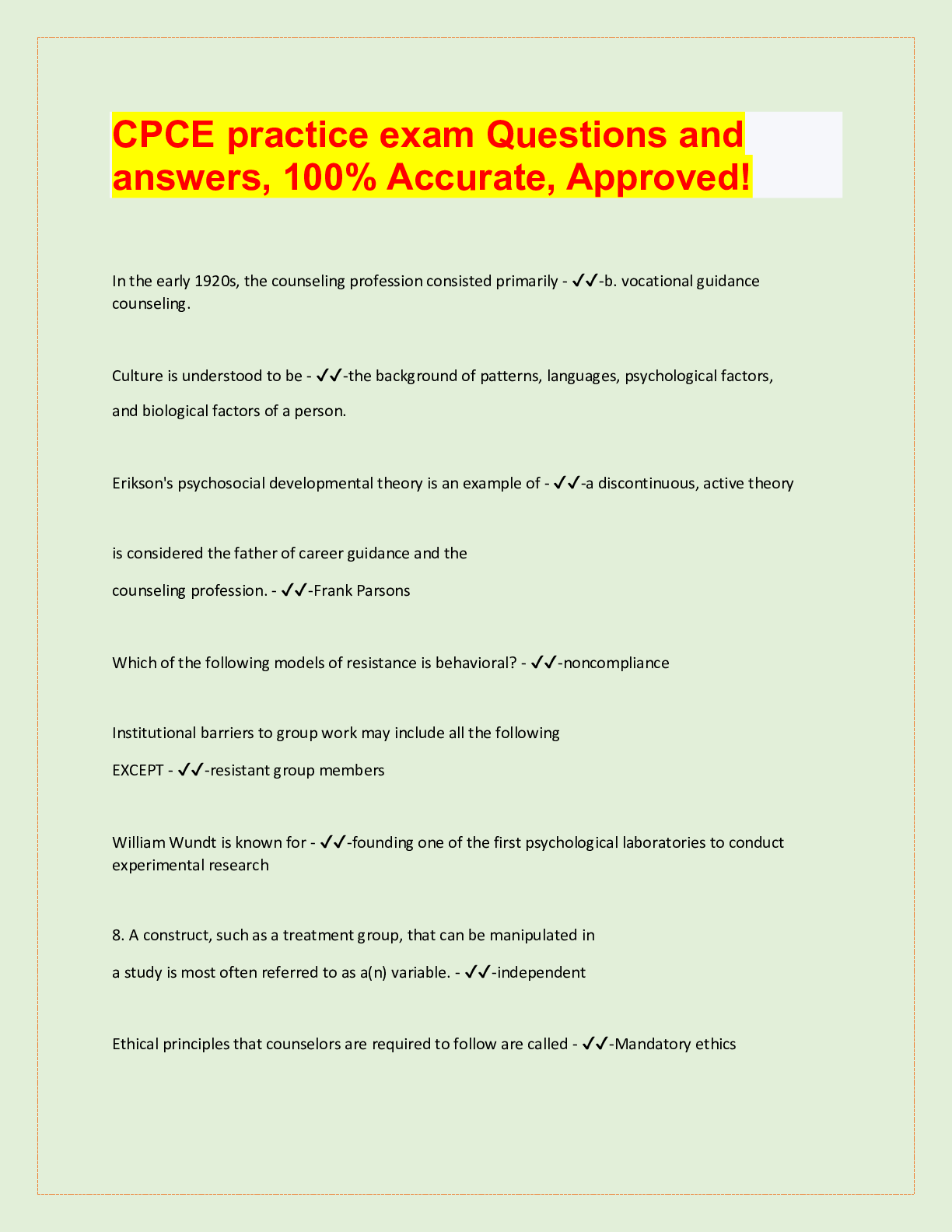*NURSING > QUESTIONS & ANSWERS > Chapter 17--Pharmacology: Nursing Management (All)
Chapter 17--Pharmacology: Nursing Management
Document Content and Description Below
Chapter 17--Pharmacology: Nursing Management MULTIPLE CHOICE 1. A client is prescribed a medication that takes several doses to achieve a therapeutic level; however, the effects of the medicat... ion are needed immediately. Which of the following can the nurse anticipate to implement in order to achieve this desired effect? 1. Administer the medication intravenously. 2. Administer the medication at hour of sleep. 3. Administer the medication before breakfast. 4. Administer a loading dose of the medication. PTS: 1 DIF: Apply REF: Pharmacokinetic Phase 2. A client is prescribed tetracycline. Which of the following should the nurse instruct the client about this medication? 1. Ingest the medication with milk products. 2. This medication does not interact with other medications. 3. Avoid exposure to the sun while ingesting this medication. 4. Blood in the urine is a common side effect. PTS: 1 DIF: Apply REF: Macrolides, Tetracyclines, Aminoglycosides, and Fluoroquinolones: Nursing Management 3. When providing nitroglycerin paste to a client, the nurse should wear gloves because: 1. putting on the paste is a sterile procedure. 2. this medication is absorbed through the skin. 3. it is part of the six rights of medication administration. 4. it is necessary for infection control. PTS: 1 DIF: Apply REF: Antianginal Agents: Pharmacokinetics 4. The nurse would report which of the following laboratory values as being within the range of toxicity for a client who is prescribed digoxin? 1. 0.5 mcg/mL 2. 0.2 mcg/mL 3. 1.5 mcg/mL 4. 2.7 mcg/mL PTS: 1 DIF: Apply REF: Cardiac Glycosides: Laboratory Monitoring 5. When instructing a client regarding the correct method to utilize nitroglycerin tablets, the nurse tells the client if the pain persists after three tablets are used at 5 minute intervals, the client should: 1. call 911 and go to the hospital. 2. sleep for 1 hour and see if the pain is resolved. 3. take a fourth tablet and the pain will go away. 4. drink an extra glass of water to help with digestion. PTS: 1 DIF: Apply REF: Antianginal Agents: Side Effects and Adverse Effects 6. When instructing a client diagnosed with hypertension on the purpose of a diuretic, the nurse should explain the mechanism of action to be: 1. promoting sodium and water loss. 2. retention of sodium and water. 3. working on the heart vessels. 4. decreasing heart rate. PTS: 1 DIF: Apply REF: Diuretics 7. Before administering a furosemide (Lasix) to a client, which of the following laboratory values should the nurse assess? 1. White blood cell count 2. K+ (potassium) 3. Prealbumin 4. Platelet PTS: 1 DIF: Apply REF: Diuretics: Indications 8. The nurse is reviewing the laboratory values for a client prescribed theophylline (Theo-Dur). Which of the following would indicate a therapeutic level of this medication? 1. 2.0 mcg/mL 2. 5.0 mcg/mL 3. 15 mcg/mL 4. 25 mcg/mL PTS: 1 DIF: Analyze REF: Respiratory Agents: Laboratory Monitoring 9. The nurse should monitor which laboratory test for a client who is prescribed valproic acid (Depakote) for a seizure disorder? 1. Complete blood count 2. Serum sodium level 3. Liver function studies 4. Sedimentation rate PTS: 1 DIF: Apply REF: Antiseizure Medication: Side Effects and Adverse Effects 10. A client is diagnosed with duodenal ulcers. Which of the following medications should the nurse prepare to administer to this client? 1. Carbamazepine 2. Ranitidine 3. Phenytoin 4. Phenobarbital PTS: 1 DIF: Apply REF: Histamine 2 Antagonists and Proton Pump Inhibitors: Pharmacokinetics 11. A client has been prescribed a hydrogen ion antagonist for several years. Which of the following is this client at risk for developing? 1. Pancreatitis 2. Liver necrosis 3. Hepatic failure 4. Vitamin B-12 deficiency PTS: 1 DIF: Analyze REF: Histamine 2 Antagonists and Proton Pump Inhibitors: Side Effects and Adverse effects 12. The nurse is instructing a client diagnosed with diabetes mellitus on the side effects of insulin therapy. Which of the following should the nurse instruct as being the most serious side effect of this medication? 1. Extreme thirst 2. Increased urine output 3. Low blood sugar 4. Dry mucous membranes PTS: 1 DIF: Apply REF: Antidiabetic Agents: Side Effects and Adverse Effects 13. A client diagnosed with type 2 diabetes mellitus is prescribed acarbose (Precose). Which of the following is an indication that this medication is effective? 1. Lower blood glucose level after a meal 2. Higher blood glucose level in the morning 3. Higher blood glucose level after a meal 4. Increase in urine output PTS: 1 DIF: Analyze REF: Oral Hypoglycemia Agents 14. After laboratory tests are completed, it has been determined that a client is adhering to medication and diet therapy to control type 1 diabetes mellitus. Which of the following diagnostic tests would provide this information? 1. Fasting blood glucose level 2. Two-hour postprandial glucose level 3. Hemoglobin A1c 4. Blood glucose level at hour of sleep PTS: 1 DIF: Analyze REF: Antidiabetic Agents: Laboratory Monitoring MULTIPLE RESPONSE 1. The nurse is preparing to administer an ACE inhibitor to a client. Which of the following should the nurse do prior to implementing this medication? (Select all that apply.) 1. Monitor peripheral circulation. 2. Administer 1 hour before meals. 3. Provide with prescribed diuretic. 4. Headache is a common side effect after the first dose. 5. A fever is a common side effect. 6. Provide after a full meal. PTS: 1 DIF: Apply REF: Box 17-4 Administration of ACE Inhibitors 2. While providing medications to a client, the nurse adheres to the rights of medication administration. Which of the following actions support these medication rights? (Select all that apply.) 1. Checking the client’s armband 2. Documenting the client’s response 3. Identifying the client’s history of hypertension 4. Checking the MAR with the medication for the dosage 5. Checking the physician’s order for the prescribed route 6. Providing the morning insulin dose before breakfast PTS: 1 DIF: Apply REF: Safe Medication Administration 3. A client is diagnosed with a severe skin infection that has been resistant to many antibiotics. The nurse realizes that the client might be prescribed which of the following medications to help combat this infection? (Select all that apply.) 1. Carbapenems 2. Ketolides 3. Streptogramins 4. Oxazolidinones 5. Cyclic lipopeptides 6. Aminoglycosides PTS: 1 DIF: Analyze REF: Newer Anti-Infective Agents 4. A client is prescribed an inhaled corticosteroid. Which of the following should the nurse instruct the client regarding potential side effects of this medication? (Select all that apply.) 1. Pharyngeal irritation 2. Pneumonia 3. Sore throat 4. Cough 5. Dry mouth 6. Sinusitis PTS: 1 DIF: Apply REF: Inhaled Corticosteroids: Side Effects and Adverse Effects 5. A client is diagnosed with elevated triglyceride and very low-density lipoprotein levels. The nurse realizes that which of the following medications might be indicated to treat this client? 1. Statins 2. Bile acids 3. Clofibrate 4. Gemfibrozil 5. Nicotinic acid 6. Nitroglycerin PTS: 1 DIF: Analyze REF: Antilipemics: Indications [Show More]
Last updated: 1 year ago
Preview 1 out of 6 pages
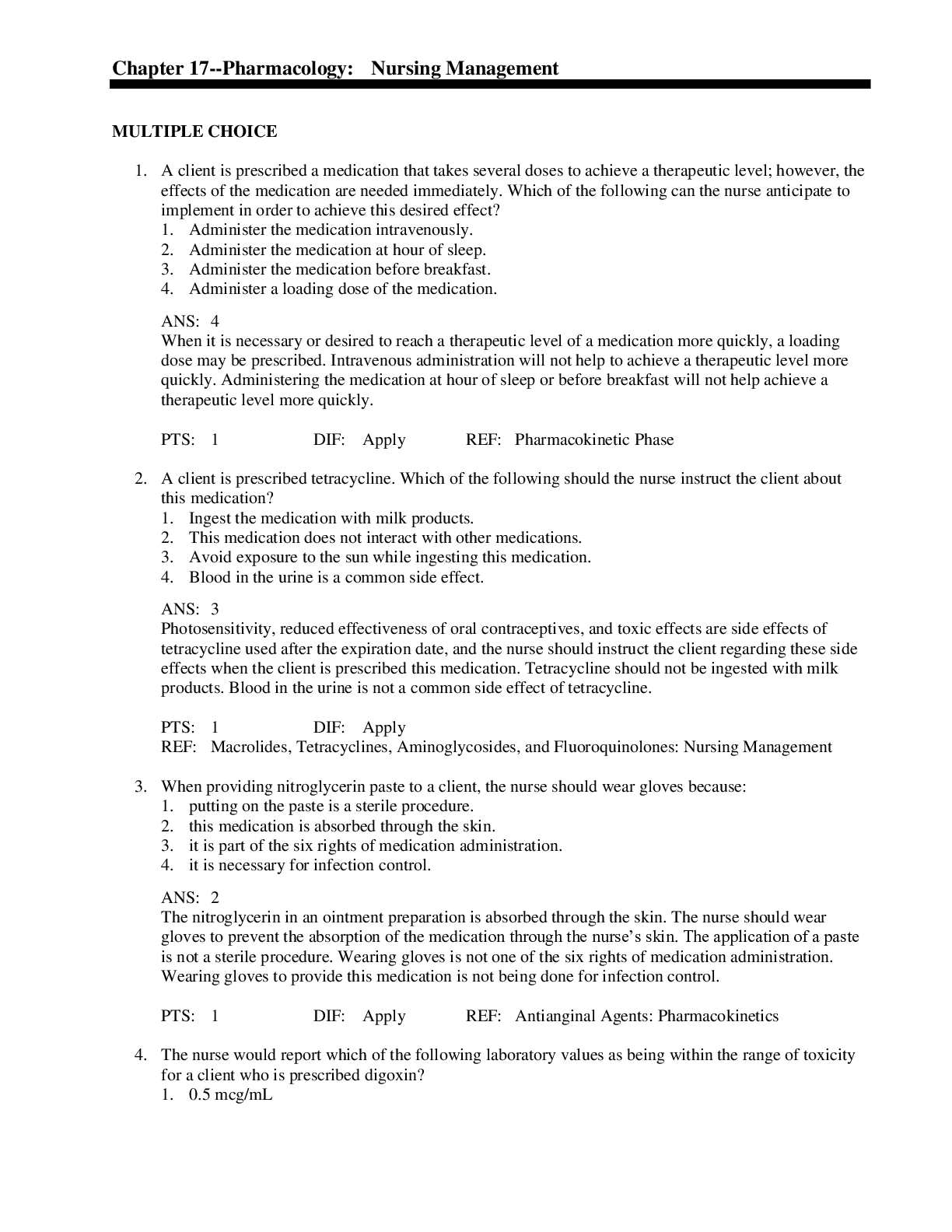
Reviews( 0 )
Document information
Connected school, study & course
About the document
Uploaded On
Jan 28, 2020
Number of pages
6
Written in
Additional information
This document has been written for:
Uploaded
Jan 28, 2020
Downloads
0
Views
43








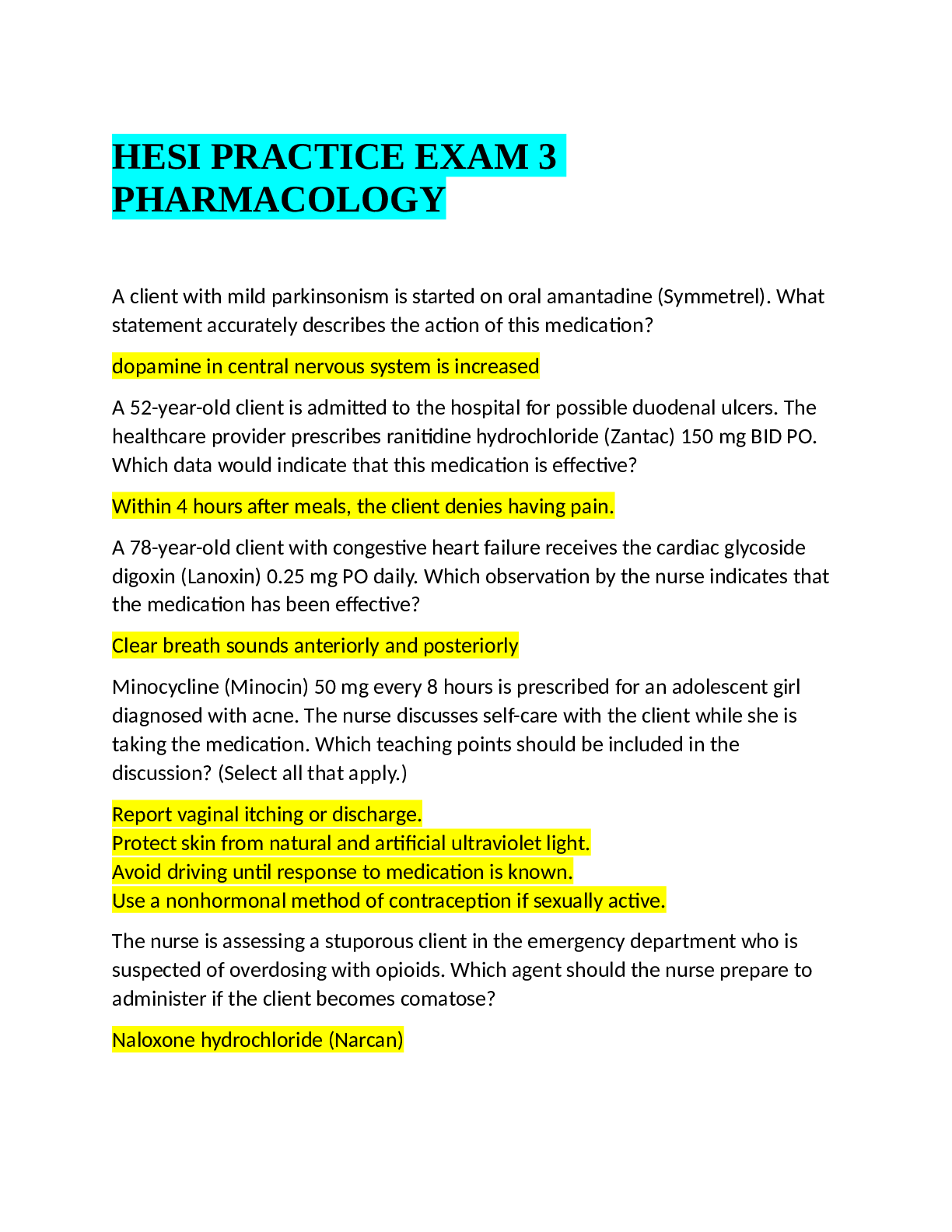




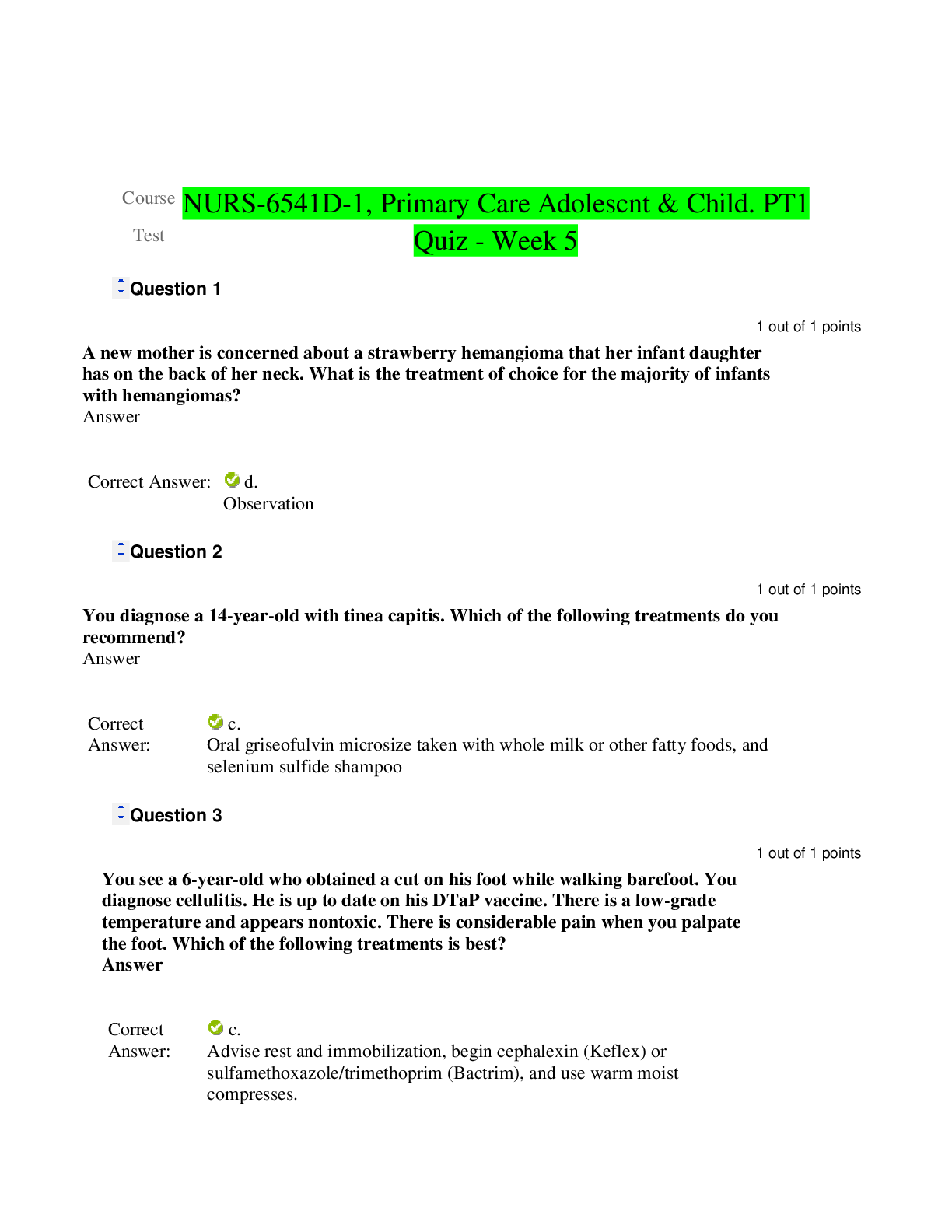
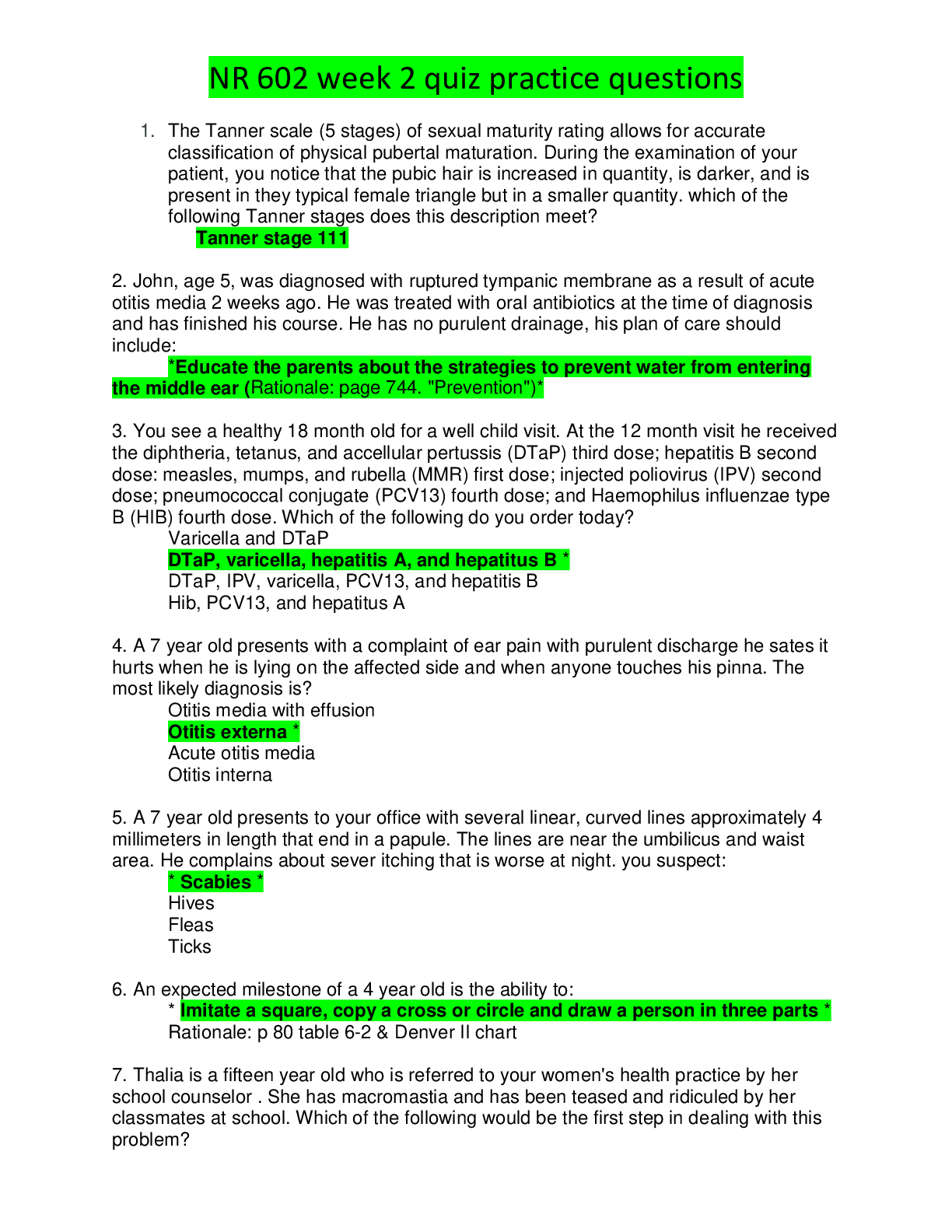
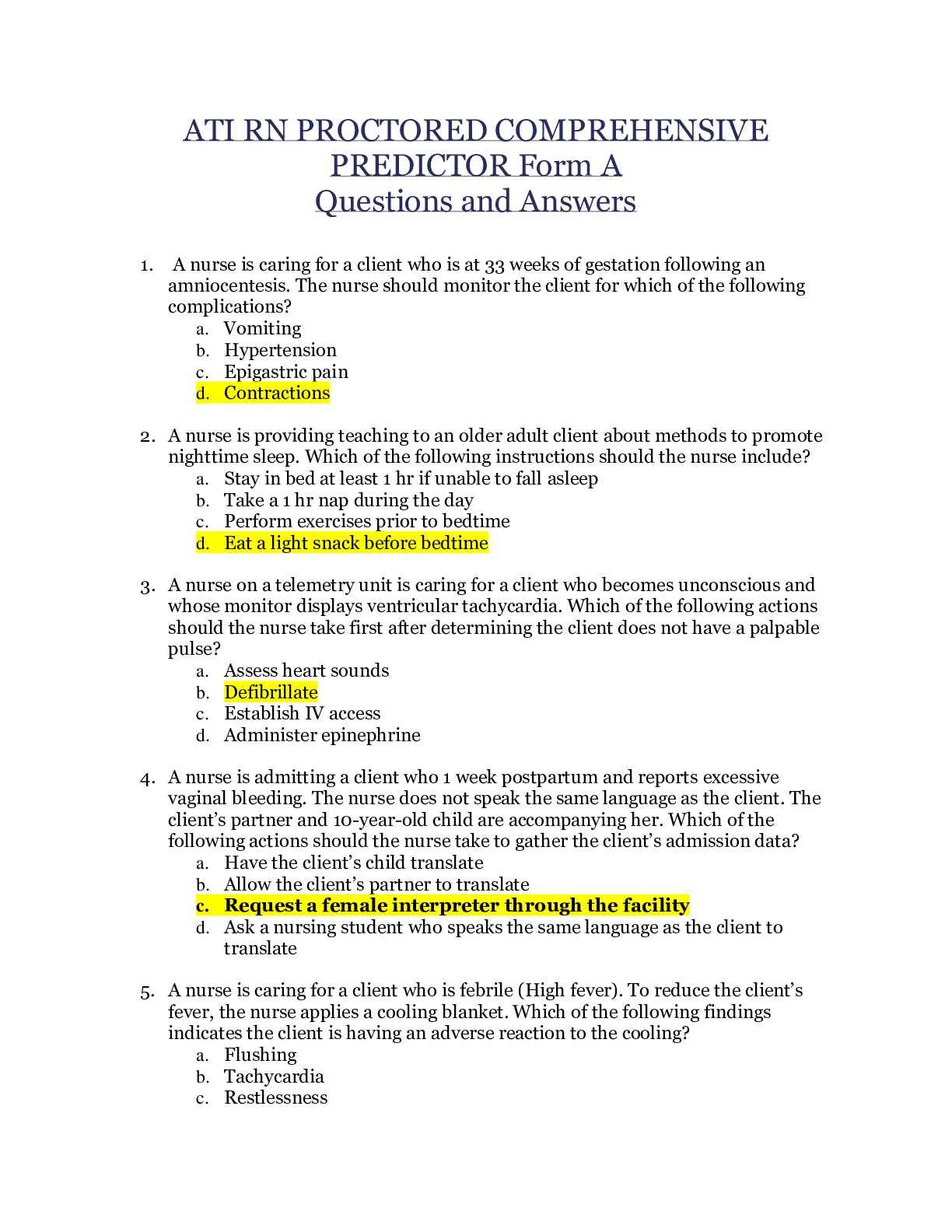
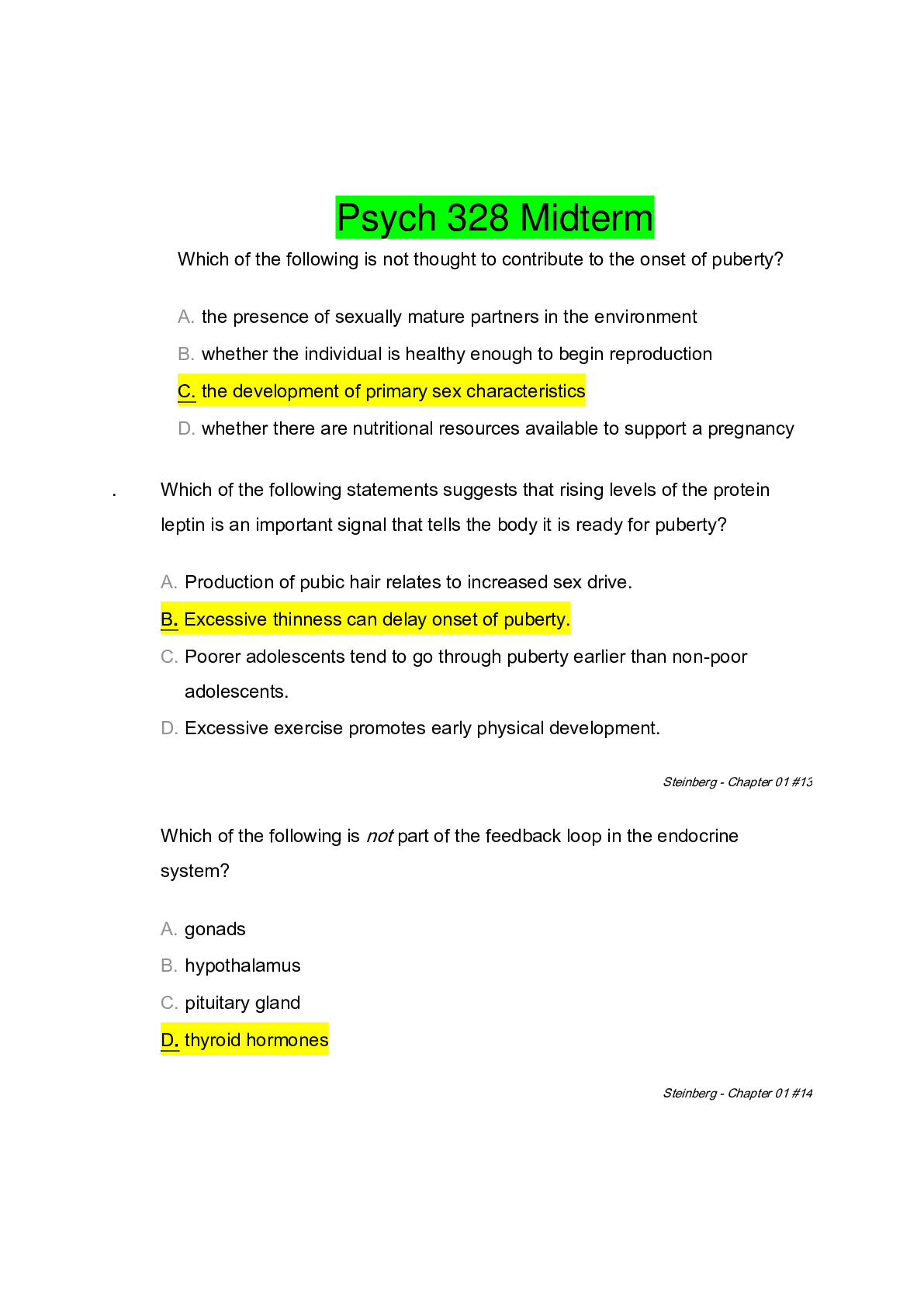


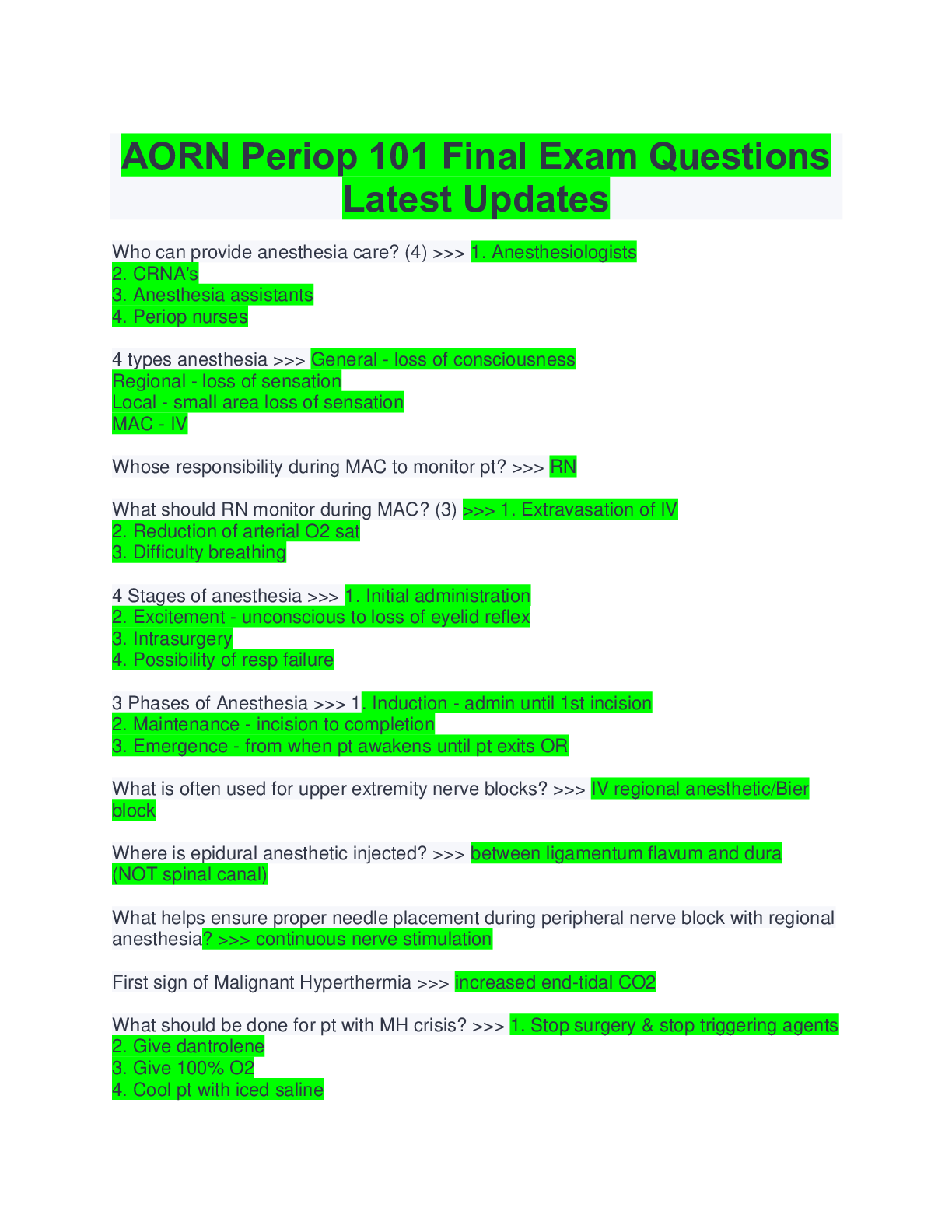










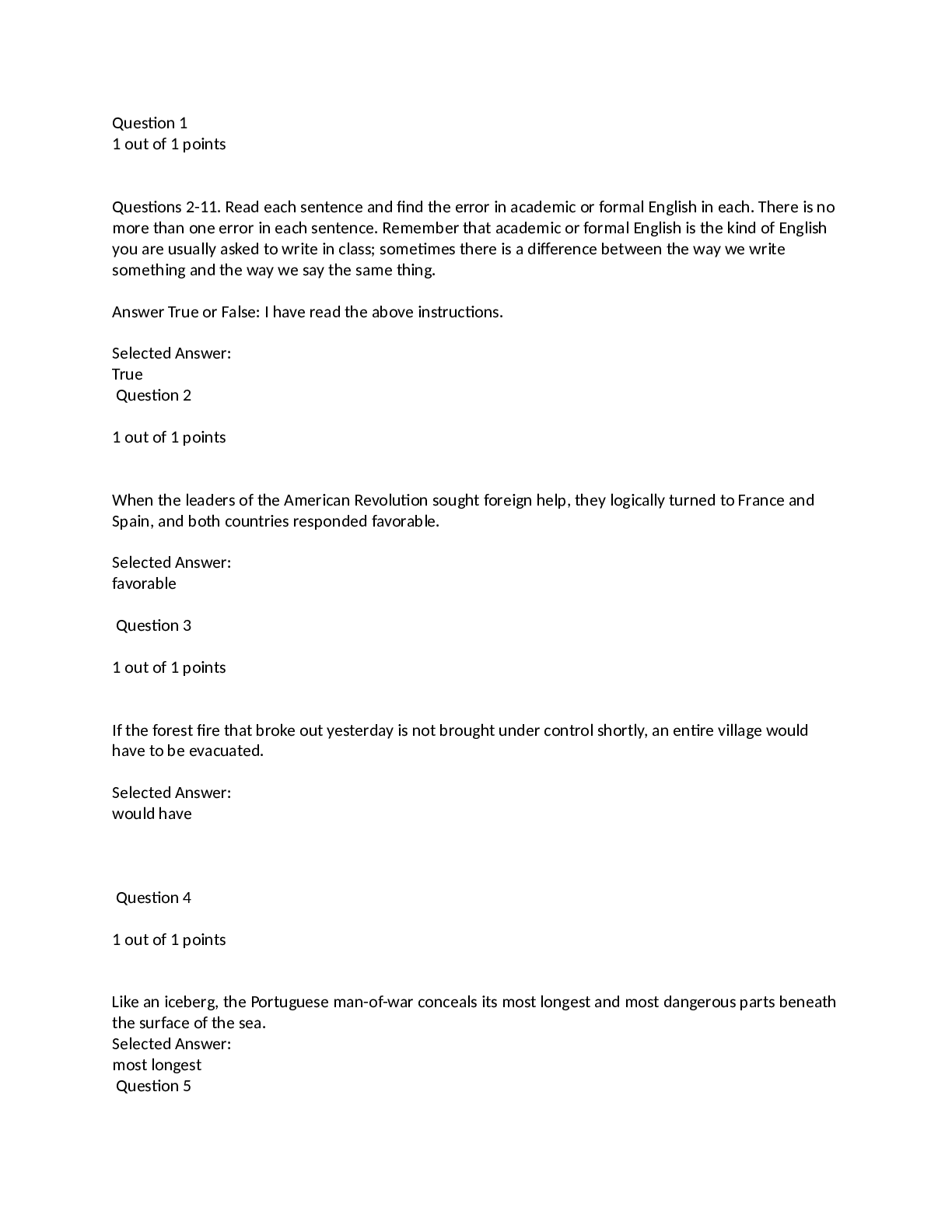
.png)
